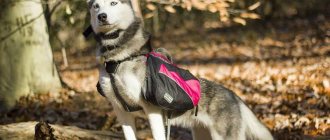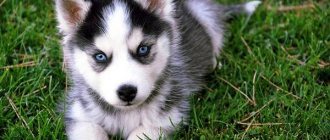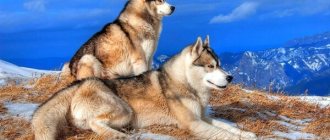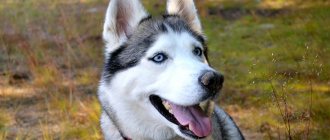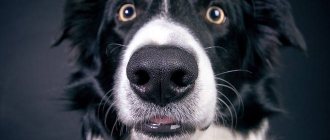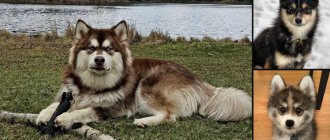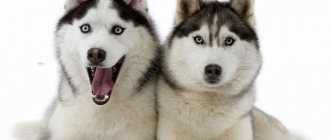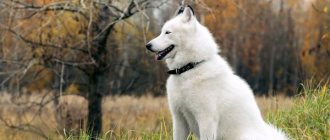History of the breed
It is believed that the husky originated among a tribe of Siberian nomads. The history of this breed is relatively unknown, but DNA analysis confirms that it is one of the oldest dog breeds. We know that nomads used dogs for fast transport and that they lived with their families. Huskies often slept with children and kept them warm.
The Siberian Husky was introduced to Alaska in 1908 and was used as sled dogs during the Gold Rush. They were used in the All-Alaska Sweepstakes, which is a 408-mile sled dog race.
History of the origin of the Husky breed: the beginning
In order to begin an excursion into the origin, it is necessary to first determine the source of the name of the breed. By the way, there are several options:
- The history of the origin of the Husky breed originates in the northern lands. And the word “husky” once meant Eskimos. But I don’t advise you to rush to look for the deep subtext of such a name. It's very simple: "husky" is just a corruption of "eskey". I think many have already guessed that “Eski” and “Eskimo” are one and the same. Only the first option is slightly distorted and has, one might say, slang origin.
- The breed is extremely accurately named also because “husky” in English means “husky.” And this is not a coincidence: the fact is that this breed tends to make growling, hoarse sounds.
So where did the story of this “Growling Eskimo” come from? Around 4,000 years ago, people from what is now Central Asia migrated to the northern regions. And not alone, but with smaller brothers.
We can safely say that the origin of the Husky breed is related to wolves, since active crossing with them took place in the North.
This northern dog lived approximately in the northeastern region of Siberia. For several thousand years, the Chukchi associated their life with this wonderful dog. The fact is that “training” and “husky” are easily compatible concepts, so this breed makes an excellent work companion. The Chukchi were not in the habit of leaving written evidence. However, I think the nuances of their way of life many centuries ago are easy to understand for the reason that they have undergone virtually no changes. By the way, I note that the Husky breed has undergone minimal changes since its origin. Largely due to such conservatism of the people.
How did this breed help? The fact is that a strong, hardy, discreet, intelligent, loyal and active dog could cover many kilometers on an ice-covered surface. And at the same time, I note, there is a minimum need for food! Naturally, hunting grounds did not always provide as much food to humans as required. Therefore, it was in the interests of the Chukchi to periodically move in search of it, and then return to their villages. It is not surprising that this breed of dog came in very handy. Also, in cold weather, huskies willingly shared their warmth with the children of their owners, which, I suspect, significantly helped their survival.
Best of breed
Togo , a Siberian Husky, was the lead dog in Leonardo Seppala's team during the Great Race of Charity of 1925. The dog was born on October 17, 1913 from huskies Dolly and Saggen, owned by Leonard Sapela. He received his nickname in honor of the famous Japanese admiral Togo Heihachiro.
The dog Togo was unsociable, had health problems and did not appear to be a potential sled dog. For these reasons, Leonardo Seppala decided to find new owners for him. First he gave it to the man. However, he was soon returned because the new owner could not cope with Togo’s character. The second owner was a woman who tried to make him a lap dog, but Togo ran away from her too. The puppy returned to Leonard Seppala again and he decided to leave him when he escaped from the enclosure and caught up with the dog sled. By this he proved his devotion and endurance. Togo was placed next to the leader of the team and, with an injured leg, dragged the natra 75 miles, thereby showing his work much better than many working dogs. Leonardo Seppala later admitted: “I found the natural leader I had been trying to bring out for years.” Togo became a favorite and famous throughout Alaska for his participation in racing.
In 1925, a diphtheria epidemic suddenly broke out in the city of Nome, isolated from the outside world. Leonardo Seppala, like many others, decided to take part in the Great Race of Mercy and took his favorite Togo, who was already 12 years old at that time, into the harness. From January 31 to February 1 there was a relay race, the main task of which was to deliver serums with medicine. Leonardo Seppalo walked 264 miles (425 km) with Togo. There were many obstacles and dangers along the way. A snowstorm and twilight prevented Leonardo Seppala from seeing the road, but Togo led them to a roadside house, thus preventing the death of the entire team. Several times they almost fell through the ice. The team managed to reach Golovin, where he passed the baton to Charlie Olson. When the serums were successfully delivered, all the glory was awarded to the last one to arrive in the city. It was one of Leonardo Sepalla's assistants, Gunnar Cassen, and Leonardo Sepalla's dog, Balto. Although they only ran 31 miles (that's 50 km). Later, Leonardo Seppalo said that he had been worried about the dog Togo for a long time, since he had a hard time with the journey due to his old age and called Kaasen an “upstart.”
On December 5, 1929, Togo was euthanized, and his body was stuffed, which is kept in a museum in the city of Wasilla. According to Leonardo Seppala, Togo's level of dedication, endurance and intelligence could not have been higher.
Balto is a black Siberian Husky who competed in the Great Race of Charity of 1925. The dog was born on February 10, 1919 in the city of Nome, Alaska. For most of his life, Balto transported food, as he was slow and unsuited for other work. However, he was resilient and loyal. In 1925, diphtheria broke out and it was decided to bring the serum using dog sleds, as bad weather prevented planes from taking off. The team led by Balto traveled 53 kilometers and reached the city of Nome. The serum was delivered and five days later the diphtheria was stopped.
Gunnar Kassen and Balto became famous all over the world after the relay. Hollywood producer Sol Lesser invited Gunnar Kaasen and his team to take part in a tour of the United States. But later it turned out that the producer did not hire, but bought the entire team from the owner Leonardo Seppala. The tour ended with the presence of Gunnar Kaasaen at the unveiling of the Balto monument in New York on December 17, 1925. After the tour ended, Gunnar Kaasaen returned to Alaska, and the entire team of dogs was resold to the owner of a private theater in Los Angeles. They were very poorly maintained and looked in poor condition. Businessman Campbell discovered them there quite by accident and decided to buy them, but the new owner asked for a very high amount - $2,000. People responded to Campbell's call to help the team of rescuers and after 2 weeks the money was collected. On March 19, 1927, the heroes were greeted with honor in Cleveland, where they were taken to the local zoo. They lived surrounded by care until the end of their days. Balto died at the age of 14 and after his death became a museum exhibit.
Research project "Husky" (5th grade)
Target:
study the characteristics of the Husky dog breed, find out the conditions for keeping dogs of this breed in our area.
Tasks:
- Study the characteristics of the breed;
- Find out the lifestyle of dogs of this breed
- Find out whether our conditions are suitable for keeping these dogs.
Hypothesis:
As you know, Huskies are northern dogs, let’s assume that keeping them in our area will also be comfortable for them. And the “riding” instinct will not make them miss the vastness of the far north.
Study design (methods):
- Study the history of the creation of the breed;
- Study the characteristics of the breed and the peculiarities of keeping Husky dogs from literary and Internet sources (theoretical analysis);
- Observation of a pet (practical observation).
Relevance of the project:
Animals are a source for various types of activities - observation, play, work, creativity, etc. As a result, curiosity and observation are formed, imagination develops, and love for nature and its inhabitants.
This is also relevant for me, because I have this breed of dog at home and I want him to be comfortable in everything.
Dogs are man's best friends, irreplaceable in guard duty, hunting and sports.
Having a dog is a big responsibility, which is why it is so important to know everything about them.
- History of the Husky breed.
The description of this dog breed suggests that these animals first appeared among the Chukchi. There was a time when this semi-nomadic tribe needed to expand their hunting territories, and for this they needed a dog capable of quickly moving over long distances and transporting cargo from commercial hunting grounds to permanent settlements and back. The small size of the Chukchi dogs was compensated by the large size of a typical team, numbering 15-17 dogs.
The dogs were kept by the Chukchi directly in their homes, so they were bred to be extremely non-aggressive towards humans and loving to play with children.
A long history connects the Siberian Husky with this people, perhaps three thousand years or more, and is an important point in the survival of this breed and its introduction into Chukchi culture. It is difficult to find any written evidence since this people did not write down their history, but their way of life remained unchanged for centuries because they were not ready to accept change and preferred to follow traditions.
Their way of life was of two types. People living in the interior of the continent kept reindeer, and dogs lived in their settlements, but these were not at all the same dogs that accompanied people living on the coasts of the Arctic and Pacific Ocean, that is, in those areas that were not subject to Russian influence until beginning of the 20th century. The latter were the Chukchi who bred their own breed of sled dogs. The Chukchi were not nomads, they were a sedentary people who lived permanently along the Arctic coast. Here they survived a series of wars between the Russians and the Eskimos for possession of the Bering Strait. Driven into increasingly deteriorating hunting grounds, the Chukchi were forced to breed dogs that could, with minimal food requirements, travel long distances across the ice-covered sea to Chukchi hunting grounds, and then return back to their villages. Thus, they were able to develop the breed of dogs known today.
Their isolation became the basis of the purity of the dog breed and the maintenance of the integrity of their culture until the middle of the 19th century. It is interesting to note that the small size of the dogs was made up for by their large number in the team; mushers often borrowed dogs from other villages when they went on long journeys to fill a team of 16 or 18 dogs. We can observe many similarities between Chukchi dogs and modern Siberian huskies. Their speed, endurance, ability to cover long distances with minimal energy expenditure - all this has been preserved in modern dogs. It should be added that Husky males are very reserved and full of dignity, while females are affectionate and intelligent. Huskies often slept in the snow houses of the Chukchi, where they warmed children with their warmth, which distinguished them from the dogs of other peoples of the Arctic. Therefore, modern huskies equally love the warmth and comfort of home, racing and playing outside.
In 1880, gold was discovered in Alaska, and thousands of gold seekers immediately went there for their fortune. A few were lucky; the whole mass of people needed food and transport. The cold climate contributed to the unexplored nature of these territories on the edge of the earth. For a long time, there was only one way to develop this land - dog sleds. These teams collected local dogs - local northern types and large southern breeds with short hair and floppy ears. Most of these dogs were simply stolen from their owners and brought to the North. Nome was a typical city of the time, in which dogs were essential to human survival, and dog sleds were both a source of pride for their owners and a means of transportation. There are many stories about the advantage of one team of dogs over others, which became obvious after the races.
- Merits of Husky.
Legendary Seppala.
In the period 1915 to 1917, Leonard Seppala with a team of Siberian huskies invariably won races across Alaska. This man became a legendary musher. Seppala, a Norwegian by birth, arrived in Alaska in search of gold at the beginning of the century. He first took part in racing in 1914, when he became the owner of a team of dogs. Subsequently, he took part in the unsuccessful expedition of explorer Ronald Amundsen, after which he was left with dogs in his arms.
Seppala's most famous legend began in 1925, when he and his dog team played a major role in delivering anti-diphtheria serum from Nenana to Nome. An outbreak of diphtheria in Nome earlier in the year quickly depleted antitoxin supplies, which could only be replenished in Anchorage. Antitoxin could also be brought by train from Nenana, but this could be done quickly by dog team. To speed up transportation from Nenana, it was decided to use a relay race of dog sleds, and Seppala set out from Nome on his sled to meet them. At the meeting, Seppala was given the serum and he headed back to Nome. It was a very risky and difficult undertaking, associated with great dangers. Thanks to the courage of the musher and the endurance of his dogs, the diphtheria epidemic was defeated, and Seppala himself became a hero. His most famous dog team leader for many years was Togo, who led the team during this famous whey run. This heroic story is commemorated by the sled dog statue in New York's Central Park.
After this race, Seppala came to the east coast of the United States with his team of Siberian Huskies, which won in Alaska. Seppala's achievements were used to advertise Siberian huskies
like the breeds during his travels across America.
On the way back to Nome, struck by the epidemic, Seppala, moving 80 km. on the ice of the Bering Sea, he risked drowning himself, the team, and, most importantly, the vaccine. Only an experienced leader could help avoid this fate, and most importantly not doom the city to extinction. Togo warned the musher about cracks and holes, forced the weather-worn dogs to work, and chose the right direction in the pitch darkness. The return journey of the team with the leader Togo was approx. 170 km. and then a team of dummies was waiting for them with the musher Gunar Kasson with the leader Balto. The heroic path of 10-year-old Togo on this path turned out to be tragic and last. When his team reached the decoys, the courageous dog lost its paws. The last section of the route is 80 km. the vaccine was carried by a fresh team with a young leader, Balto. The entire journey with the vaccine took almost five and a half days and, during this time, the dogs covered about 550 km. And now there is a monument to Balto in New York's Central Park, although Togo's name should be written under it.
Siberian Huskies were officially recognized by the American Kennel Club in 1930, and the first breed standards were issued in 1932. In 1938, the Siberian Husky Lovers Club was founded in America. (According to PCI standard No. 270, the Siberian Husky breed has American citizenship, despite its obvious historical homeland - the USSR. Only the Samoyed Laika has dual citizenship - the USSR and Scandinavia.
- Sled Huskies.
No one knows exactly when people first adapted dogs for sledding. Probably, the peoples of Eurasia were the first to put harnesses on dogs. It is known that the Eskimos used sled dogs as early as 1,500 years ago, but there is evidence of the existence of sled dogs 4,000 years ago and earlier. Accompanied by jackal-type dogs, the people of Central Asia migrated to the outskirts of Siberia and the Arctic. Their dogs, which were crosses with local wolves, eventually turned into those breeds that are commonly called northern breeds of Dogs. From this early group of breeds the modern breeds were developed and have retained their individual characteristics after all these years. Among these northern breeds, Siberian Huskies are the most famous breed.
It is believed that Siberian Huskies
bred by the Chukchi living in North-Eastern Siberia. A long history connects the Siberian Husky with this people, perhaps three thousand years or more, and is an important point in the survival of this breed and its introduction into Chukchi culture. It is difficult to find any written evidence since this people did not write down their history, but their way of life remained unchanged for centuries because they were not ready to accept change and preferred to follow traditions.
Their way of life was of two types. People living in the interior of the continent kept reindeer, and dogs lived in their settlements, but these were not at all the same dogs that accompanied people living on the coasts of the Arctic and Pacific Ocean, that is, in those areas that were not subject to Russian influence until beginning of the 20th century. The latter were the Chukchi who bred their own breed of sled dogs. The Chukchi were not nomads, they were a sedentary people who lived permanently along the Arctic coast. Here they survived a series of wars between the Russians and the Eskimos for possession of the Bering Strait. Driven into increasingly deteriorating hunting grounds, the Chukchi were forced to breed dogs that could, with minimal food requirements, travel long distances across the ice-covered sea to Chukchi hunting grounds, and then return back to their villages. Thus, they were able to develop the breed of dogs known today. The Chukchi were a very independent people. The Russian Empire constantly tried to annex the Chukchi lands; these attempts continued until the middle of the 18th century. These people survived through their tenacity and independence, and with the help of their dogs, and in 1837 a treaty was signed giving the Chukchi political and cultural independence from Russia.
Their isolation became the basis of the purity of the dog breed and the maintenance of the integrity of their culture until the middle of the 19th century. It is interesting to note that the small size of the dogs was made up for by their large number in the team; mushers often borrowed dogs from other villages when they went on long journeys to fill a team of 16 or 18 dogs. We can observe many similarities between Chukchi dogs and modern Siberian huskies. Their speed, endurance, ability to cover long distances with minimal energy expenditure - all this has been preserved in modern dogs. It should be added that Husky males are very reserved and full of dignity, while females are affectionate and intelligent. Huskies often slept in the snow houses of the Chukchi, where they warmed children with their warmth, which distinguished them from the dogs of other peoples of the Arctic. Therefore, modern huskies equally love the warmth and comfort of home, racing and playing outside. Dog racing was not uncommon at that time. In 1869, the famous competition between a Russian officer and a Chukchi took place; it was a 240-kilometer run along the coast, which the Chukchi covered an hour before the Russian officer.
Racing through Alaska.
“In 1880, gold was discovered in Alaska, and thousands of gold seekers immediately went there for their fortune. A few were lucky; the whole mass of people needed food and transport. The cold climate contributed to the unexplored nature of these territories on the edge of the earth. For a long time, there was only one way to develop this land - dog sleds. These teams collected local dogs - local northern types and large southern breeds with short hair and floppy ears. Most of these dogs were simply stolen from their owners and brought to the North. Nome was a typical city of the time, in which dogs were essential to human survival, and dog sleds were both a source of pride for their owners and a means of transportation. There are many stories about the advantage of one team of dogs over others, which became obvious after the races.
In 1907, the Kennel Club was founded in Nome as the organizing and sponsoring body for racing across Alaska. The rules were developed and the route was chosen. She walked from Nome to Kendle and back; this distance was 653 km, this route presented a wide variety of different natural conditions and landscapes. The races were scheduled for April, so preliminary races were held all winter to train dogs and mushers on this track.
The first races were held in 1908, and in the same year the Russian fur trader William Gusak brought a team of small dogs from Siberia. (Siberian huskies were also called “Siberian mice” because of their small size. - Ed.) These dogs were so small compared to Alaskan sled dogs that Gusak laughed for a long time. At the 1909 races, the musher of his team was the Norwegian Thorstrup, and the team itself came third due to the fault of the musher. A young man named Foke Maul Ramsey, a Scottish gold miner and athlete, was so pleased with the running qualities of these small dogs that he chartered a ship and went to Siberia for a new batch of huskies. The following summer, he bought about 20 Siberian Huskies from a settler named Markov, who lived in Anadyr. Ramsey brought the dogs again to Nome along with two Chukchi mushers. During this period, interest in racing only increased, lighter harnesses for dogs were developed, san became easier, and the racing itself became a more serious type of competition.
In 1910, Ramsey entered three teams of Siberian Huskies into the race. One team was driven by John Ironman Johnson (“Iron Man”), who set a record in 74 hours, 14 minutes and 37 seconds that no one could break. Ramsey was second. This is how the popularity of Siberian Huskies began to grow. (The Siberian, or Arctic, Husky (53-60 cm at the withers) is considered the fastest and hardiest breed among Alaskan sled dogs. Huskies were specially bred in the Chinook kennel (New Hampshire) for Beard’s Antarctic expeditions.
- Features of the breed.
The characteristic features of the husky are friendliness and a peaceful attitude towards people, while being distrustful of strangers. This breed does not have the qualities of a guard dog and is hardly suitable for protective service. But among sled dogs they have no equal, as evidenced by the history of the breed, the use of Husoks by the peoples of the north and numerous awards at races.
Raising a husky due to the typically northern origin of the breed, its archetype, instinctive affinity for the wolf, as well as natural intelligence, can be considered a rather complex process that requires deep knowledge and experience.
These dogs are very comfortable living with other dogs in a pack. If a husky is the only dog in the house, he should be able to communicate closely with everyone in the household and be actively involved in the life of the family.
If you give your pet due attention, Husky will become a reliable and attentive friend to its owner.
- Conclusion:
Huskies are friendly and peaceful dogs. Perfectly adapted to harsh northern latitudes. They can sleep covered in snow. Very hardy and united in a team, which is the main characteristic of sled dogs. The Husky's natural intelligence, correct, competent approach to education, patience, love and care will allow you to raise a reliable and loyal friend.
Conclusion:
Having studied and analyzed a lot of information on this breed of dog, I came to the conclusion that my pet is comfortable in our area. I will be happy to take care of my pet.
Literature:
1. http :// haski - club . com / info / istoriya - porodyi /
History of the Siberian Husky breed
2. https://lifeglobe.net/blogs/details?id=443
History of the Siberian Husky
Husky character
- Vigilant
- Smart
- Hardy
- Active
- Friendly
- Vigorous
What conditions make up a dog's character? It is widely believed that the character of a four-legged pet is determined at the genetic level. Also, many people close to cynology argue that character traits are nothing more than the consequences of training and daily upbringing of a puppy. The conditions under which the pet is kept also play an important role. You should not expect your pet to be sociable and friendly towards people if he has been shouted at since childhood, waved at with a leash, or with a newspaper.
Experienced dog breeders will certainly say that if you want to achieve mutual understanding with your own pet, then you must match in temperament and in some character traits. To correctly choose the breed that suits you, first study this issue theoretically: consider the exterior of the dogs you like, read the breed standard, pay attention to the description of the temperament and characteristics of the breed's behavior, ask questions to the real owners of the breed you are interested in. If, in theory, you are satisfied with the breed of your future pet, go to a nursery, or to people engaged in private breeding. A competent breeder who cares about his breed will readily respond to your requests for help in selecting a puppy. It is difficult to say with certainty what kind of character your chosen dog will grow up to be in such a short period of time. There are several simple tests with which you can choose a little friend with the qualities you need.
Health
Like any other breed of dog, the Siberian Husky is prone to certain diseases:
- diabetes,
- problems with the thyroid gland,
- eye diseases (glaucoma, corneal dystrophy, cataracts),
- hip dysplasia.
Preventative measures to protect your husky puppy
- To keep your Husky puppy completely safe, you first need to minimize his contact with unfamiliar dogs, especially strays. Therefore, you should not let your dog off the leash, as in this case it will become impossible to control its behavior and communication with other dogs. Since a dog can easily become infected with distemper from simply touching the nose of a sick animal. This disease can be transmitted to a dog through sniffing. Your dog can become infected with trichophytosis from contact with the lichen-affected fur of a sick dog. Naturally, it is impossible to completely exclude a dog’s communication with other dogs, since it must be socialized. Therefore, try to find friends with dog lovers who look after their animals. By adhering to this rule, you can eliminate the risk of pathogen transmission by 80%.
- You should walk your dog in places where there are no landfills. Since garbage very often attracts rodents, which in turn are very often carriers of various infections. Gray rats are especially dangerous because they carry such a serious disease as leptospirosis.
- You should not allow your dog to sniff other people's feces, as they are a source of worms.
- Monitor your husky's health. Pay attention to even the most minor changes in his behavior. For example, your dog may appear lethargic, lose his appetite, or have a dry nose. Or you may notice that the dog begins to shed, and this has nothing to do with seasonal shedding. If hair loss becomes excessive, this is the first symptom indicating health problems in your pet. And only you can help him. Therefore, it is important to take the dog to the veterinary clinic in time, where the disease can be overcome for sure. In no case should you ignore the symptoms, since advanced infections are much more difficult to treat, and sometimes even impossible. If you start treating your dog, the disease can lead to his death or he will develop serious complications that will affect his hearing, vision, limbs and much more.
Where to buy a husky puppy?
A specialized nursery is the best place to buy a good husky puppy. If pedigree and thoroughbred are important, then it is better to hire an experienced dog breeder to help. If not, then you can trust your heart. On nursery websites, there are customer reviews that will help you navigate. A little secret or life hack: visit a dog show where the desired breed will be presented. Chat with the owners of the breed, ask about the nuances, find out where they purchased the puppies. True dog breeders live for their pets, so they will be happy to answer any question and give valuable advice. Typically, nurseries send their representatives to exhibitions, where there is a chance to meet in person and take a business card.
How to choose a strong and healthy husky puppy
The day has come to go to the nursery for a cute puppy. Babies should be kept in a clean enclosure, without a specific unpleasant odor, which is very important. First of all, the breeder will demonstrate the numerous awards that his pets have received. Listen carefully, but don’t be easily fooled by all the big titles and championship accolades. If possible, you need to look at the parents of the future pet. The main 10 signs that will help you choose a healthy husky puppy:
- shiny and moist nose;
- clean ears, pink;
- lively, clear look;
- clean eyes, without any discharge;
- healthy skin, without parasites, sores and acne;
- silky, shiny coat;
- lymph nodes of normal size;
- tail without creases;
- no bloating.
A good proof that the animal is healthy is a written document of purchase and sale. If a husky puppy develops abnormalities over time, according to the contract, the pet can be returned. Having “insurance” with the buyer will reduce the risk that the seller will slip in a problem animal.
Age for adoption
- Professional Russian dog breeders advise buying 8-10 week old puppies. At this age, the baby should already be vaccinated, toilet trained, and receive basic education.
- An important point: it is not recommended to take a puppy home immediately after separation from its mother. Until 9 weeks of age, the baby learns dog language and learns to communicate with its own kind. He needs to spend several weeks in a doggy daycare.
- A professional breeder knows that a Husky puppy less than 6 weeks old should not be given away. A very small puppy can only be given to an experienced owner who knows how to raise it correctly. This option is not suitable for a beginner.
- Depending on the breed, the puppy can be picked up earlier or later than 10 weeks of age. Large dogs grow more slowly, so it is recommended to remove them from kennels at the age of 3 months. Puppies of such breeds should gradually build up bone and muscle tissue, without sudden jumps, in order to avoid problems with the musculoskeletal system.
- For show- or breed-class husky puppies, the age of “adoption” can only be 6-9 months. This is a mandatory condition, because it is at this age that the makings of a champion and the distinctive signs of thoroughbred are revealed. You need to have patience to get a future titled champion.
Note : even the most expensive husky puppy cannot with a 100% guarantee become a champion. The breeder’s job is to assess the potential and make a forecast. Next, you need to raise the puppy and train it for a long time in order to realize the makings of a champion.
Documentation
- A husky puppy has a mark in the groin area or it may be on the ear, as well as a puppy card (metric). The codes on the card and on the stamp must be identical.
- Metrica is the primary document that is issued for a puppy when it reaches the age of 45 days. Next, a qualified dog handler examines the babies and notes any defects found. The owner of the dog, if desired, can change the metric to a new document, pedigree, at the age of 6-15 months. This document will allow the pet to participate in breeding.
- Another document for the puppy is a veterinary passport, with mandatory vaccination and deworming notes.
Features of color and exterior of a husky: breed standard
photo from the site: otvet.mail.ru
Huskies can be black, gray, brown and even white with characteristic markings located throughout the body. These dogs have a peculiar pattern on their faces, thanks to which they have become so recognizable. Most often these are clearly defined eyebrows and outlined eyes.
Representatives of this breed are also characterized by:
- Neat head proportional to the body.
- Almond-shaped expressive eyes, the color of which varies from brown to light blue. A common phenomenon is heterochromia (i.e., irises of different shades).
- Triangular ears set high on the head.
- Nose with well-developed nostrils - flesh-colored, brown or black (depending on color).
- Powerful jaws with fangs resembling those of a wolf.
- Developed chest, straight back and strong neck.
- Widely spaced muscular legs.
- A furry tail resembling a fox's.
Such a variety of the Husky breed as completely white individuals is extremely rare. Black and gray animals are most common, and brown ones are a little less common. But both dogs look equally impressive - the contrast of dark markings and light wolf eyes makes an impression on everyone who sees for the first time the descendants of the proud conquerors of the vast northern expanses. These pets can gain weight from 15 to 28 kg. The height at the withers of a tamed animal is up to 60 cm.
Interesting facts about huskies
- Huskies run long distances and expend little energy.
- During World War II, the dogs were used as rescue and search dogs, as well as for transportation and cargo transportation.
- Amazing blue eyes. Not every breed can boast such a piercing gaze. Weymaners and Australian Shepherds can have blue eyes due to the merle gene, which causes loss of pigmentation. Huskies can have bright eyes without this gene.
- Huskies are used as mascots and branding for many universities and sports teams.
If you decide to get a dog, then get ready for the following: you will often have to clean up little mistakes after your puppy; investments will be required in annual vaccinations, feeding, toys, ammunition, etc.; any animal requires attention and communication, so if you don’t have time, then there will be no mutual understanding with your husky puppy. Big changes are coming in your life. If you can handle this, you will find a loyal friend for life. Character of Siberian Huskies: who is better to take a bitch or a dog?
Siberian Husky The character of a dog depends on heredity and breed characteristics, but proper upbringing and training is also of no small importance. In… Read more
Siberian Husky color
Siberian Husky Color is a canine term that refers to the color of a dog's coat. It is one of the most important signs when ... Read more
Training and education of Siberian Huskies
Siberian Husky Raising a dog is about developing correct behavior. This is the basis for successful training. Training is a set of activities... Read more
Diseases of Siberian Huskies
Siberian Husky Each breed of dog has a predisposition to certain diseases. We have collected information about typical diseases of the breed. Remember the symptoms of the disease, ... Read more
How to name a husky: a list of nicknames for boys and girls
Siberian Huskies are very active sled dogs. The dogs are not aggressive, but willful and stubborn. Therefore they are not suitable for… Read more
Siberian Husky
Seppala Siberian Sleddog
FCI not recognized
Country of origin: Weight: Height at withers: Color: Other names:
The Siberian sled dog was bred exclusively to work in cold and snowy conditions. Dogs have extraordinary endurance and strength.
Seppalas are active and energetic, intelligent and capable of learning. Their purpose is to pull, so these dogs cannot do without work.
Seppala was not bred for exhibitions and shows; it is a sled dog with no show lines. It is quite possible that the Siberian Husky is the show line of the Siberian sled dog Seppala.
Despite the relatively long existence of the breed, the Siberian sled dog is not recognized by any of the existing cynological organizations.
True, in 1990 in Canada the breed was recognized as evolutionarily new and this increased its popularity. In 2002, several individual breeders from the United States brought the breed to their country for breeding.
The Siberian sled dog is not suitable for apartment living - this dog requires a lot of physical activity and constant exercise.
Seppala can live outside all year round - she is not afraid of cold and bad weather. She is not picky about food and is not prone to any diseases.
Grooming for the dog is minimal - the coat does not require frequent grooming, only during shedding it is worth paying a little attention to combing out the undercoat.
It was a harsh winter in Alaska in 1925. At the same time, there was an outbreak of the deadly disease diphtheria in the distant port of Nome, which was home to about 10,000 residents.
Children could especially suffer from the disease. But since Nome was in a difficult place, a terrible situation developed. Medicine that could help fight diphtheria was located at the Nenana train station, 674 miles from Nome. It was impossible to deliver the medicine by plane due to the ongoing snowstorm, so the management decided to deliver the serum by dog sled.
We assembled 20 teams of drivers. One of them was the team of the famous Alaskan musher Leonard Seppala. As a result of the "Great Race of Mercy", which lasted five and a half days, the life-saving medicine was delivered to the city. During the final stage of 53 miles Balto played a special role. But at the same time, the Siberian husky Togo, who accomplished an even greater feat, is undeservedly forgotten. Many witnesses to that run consider him to be the main character. Twelve-year-old Togo, running ahead of his team, covered a distance of 264 miles, while the average distance for each team was 31 miles.
The dog Balto also grew up in Seppala's kennel. A monument was erected to this glorious dog in New York in Central Park. But Togo was undeservedly forgotten. Now historians are trying to achieve well-deserved recognition for the Siberian husky Togo. In 2001, a monument was erected to Togo in Seward Park in New York, and in 2022, Disney made a film about him, starring Togo's descendant, Diesel.
The Seppala family settled in Alaska in 1900. They organized their own nursery where they raised sled dogs. At that time, the main sled dogs in Alaska were Alaskan Malamutes or crossbreds. Seppala became the strongest mahout in the region. He bought Siberian huskies from a Russian fur trader. Togo's mother was the bitch Dolly.
Togo was a sickly and disobedient puppy. He was behind in growth compared to other puppies of this breed. Seppala considered him unsuitable for the team. He tried to get rid of the non-standard puppy by giving it to his neighbor. But Togo’s devotee escaped from his new owner through the window, breaking the glass during his escape. Seppala considered him an incorrigible hooligan.
Togo grew up admiring the dogs around him. He ran alongside them during their training, often getting into mischief along the way. This upset Seppala. Often Malamutes, larger and stronger, would pat the puppy. To prevent the eight-month-old puppy from interfering with the training, Seppala put him in a harness.
As a result, the young husky managed to run 75 miles per day. He was able to climb the mountain with ease. From the first time he became the leader of the bunch. This was real luck for Seppala. Togo turned out to be the perfect dog. Togo became Seppala's main dog; he became famous throughout Alaska for his endurance and intelligence. The dog won all long and short distance competitions. The owner and the dog became one.
When the diphtheria epidemic occurred in Nome, Togo was no longer a young dog, he was 12 years old. But local residents had high hopes for the dog and its owner. Every day a new child became infected, and there were even deaths. To deliver the necessary medicine, several teams of drivers were organized to deliver 300,000 ampoules of serum brought by rail to Nenana. The dog sleds had to cover 674 miles. On January 29, 20 of the best Siberian Huskies went to Noma for serum. Balto was not among them, as Seppala decided that he could not lead the team.
The air temperature then was 30 degrees. Seppala's team covered more than 170 miles heading east. At the same time, the disease began to spread even more. Then the city leadership decided to add more teams. This was done without Seppala's knowledge. Balto entered them. Seppala's teams managed to overcome the ice-covered Norton Strait. Thus they gained time and distance. Then Seppala's teams met with Henry Ivanov's team, moving from Nenana to the west. Thus, there was a successful transfer of the baton with the medicine. Togo and his master set off back with the precious cargo.

